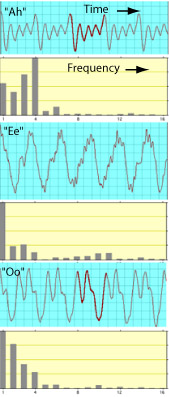Muestra de Vocales como Función del Tiempo y de la Frecuencia

|
El examen de la cualidad distinguible de la voz o timbre de sonidos vocales, se realiza con dos tipos diferentes de muestras del sonido. La visualización de la imagen del sonido como función del tiempo demuestra que las formas de ondas de los tres sonidos vocales son claramente diferentes. Este es el tipo más común de visualización según lo captura un osciloscopio o una pantalla de ordenador. El segundo tipo de pantalla muestra la imagen de sonido como función de la frecuencia. Este es un ejemplo de análisis de Fourier, y estas gráficas que muestran la cantidad de señal asociada con cada armónico de la señal de sonido, se llaman transformadas rápidas de Fourier, o FFTs. La FFT proporciona una manera de cuantificar las diferencias en el contenido armónico de los sonidos de las vocales, y proporciona una idea de cómo el oído distingue estos sonidos de vocales. Con el conocimiento proporcionado por la teoría del lugar de la percepción del tono, se puede observar que el análisis del oído humano de la cualidad del sonido tiene cierta semejanza con una FFT. |
Estas muestras fueron creadas por Elisha Huggins con MacScope2.
Conceptos de Voz
Instrumentos Musicales
Referencia
Benade
Cap. 19
| HyperPhysics*****Sonido | M Olmo R Nave |
